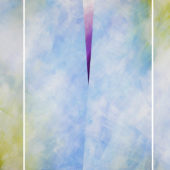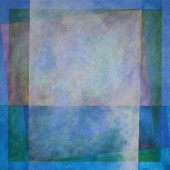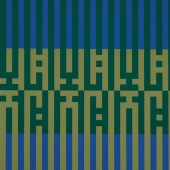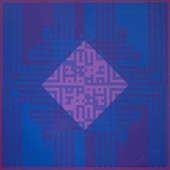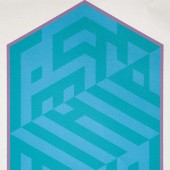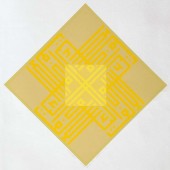Kamal Boullata
Born in Jerusalem, Kamal Boullata has created a body of work in which the Palestinian identity and the conditions
of exile form the basis of his artistic explorations.
Early in his career, Boullata developed a distinct pictorial idiom that embedded Arabic words and letters in angular Kufic script into colourful geometric designs. Particularly meaningful to the artist, calligraphy and geometric patterning evokes his time at the Dome of the Rock as a child living in Jerusalem as well as his early training under the iconic painter Khalil Halabi.
Often working in the medium of silkscreen, Boullata’s formal language also conjures up the patterning of traditional Palestinian embroidery and the geometric abstraction of western modernism. After 1967, the square became integral to Boullata’s compositions. Dissecting the square through lines and thin layers of oppositional colours, Boullata transforms the surface of the paper into a prism refracting colour and light.
Boullata graduated from the Academy of Rome and the Corcoran Art Museum School in Washington, DC. In 1993, he received a Fulbright Senior Scholar Fellowship to conduct research in Islamic art in Morocco. His publications include Palestinian Art: From 1850 to the Present and Belonging and Globalisation: Critical Essays in Contemporary art and Culture. After his extended residency between the USA and France he moved to Berlin where he was elected in 2012-13, as fellow of the Institute of Advanced Study.
Related artists by country
- Abdel Rahman Katanani
- Bashar Alhroub
- Jawad Al Malhi
- Jeffar Khaldi
- Laila Shawa
- Larissa Sansour
- Layan Shawabkeh
- Mona Hatoum
- Samia Halaby
- Shadi Habib Allah
- Steve Sabella
- Suleiman Mansour
- Tarek Al Ghoussein
- Jumana Manna
- Sharif Waked
- Paul Guiragossian
- Abdul Hay Mosallam Zarara
- Hazem Harb
- Khaled Jarrar
- Ahmad Nawash
- Asim Abu Shakra
- Khaled Hourani
- Tayseer Barakat
- Taysir Batniji
- Hani Zurob
- Shadi Alzaqzouq
- Kamel Moghani
- Yasser Dweik
- Ismail Shammout
- Mustafa Al Hallaj
- Jabra Ibrahim Jabra
- Suha Shoman
- Vera Tamari
- Ufemia Rizk
- Ghassan Kanafani
- Jumana El Husseini
- Maliheh Afnan
- Essa Grayeb
- Tammam Al-Akhal
- Samira Badran
- Abed Abedi
- Nabil Anani
- Ruba Salameh
- Samia Zaru
- Amjad Ghannam
- Juliana Seraphim
- Walid Abu Shaqra
- Zulfa Al Saadi
